#Maxine Elliott's Theatre
Text
FIXING SISTER
1916
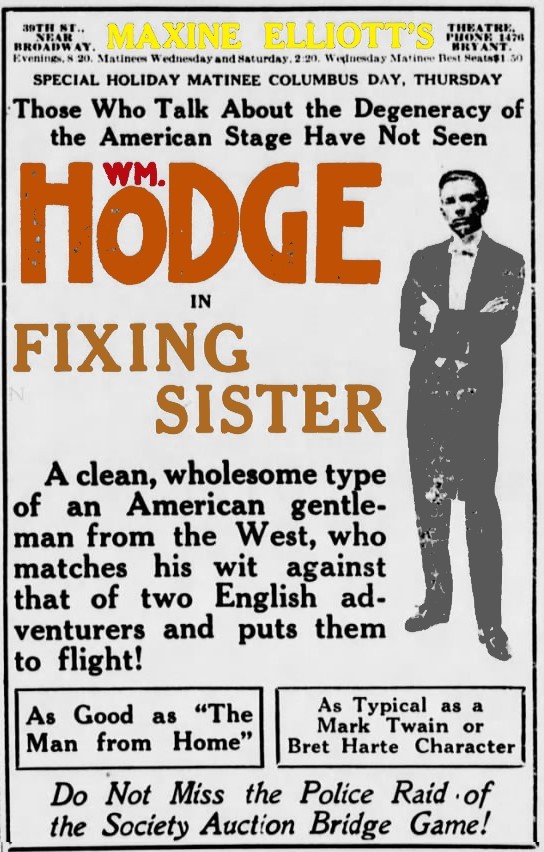
Fixing Sister is a four-act play by Lawrence Whitman (aka William Hodge). It was originally produced by Lee Shubert starring Mr. Hodge.
‘Fixing Sister’ tells how a devoted brother outwits a headstrong sister who has been carried away by the temptations of luxury, title-hunting, and bridge whist gambling, in the midst of the gay society life of the metropolitan rich. As a result of her foreign travels, she has almost annexed a foreign nobleman of untested lineage. Her brother. John Otis, a representative American of a shrewd and humorous sort, learning of his sister’s peril, hastens to New York from Kansas City. It Is his native common sense and shrewdness which effect a not sudden, but finally very effective, cure, including staging a police raid at her bridge party. He also rescues his own sweetheart, a tantalizingly Independent sort of American girl, from the wiles and the guiles of New York society and foreign nobility.
All four acts take place in New York City.
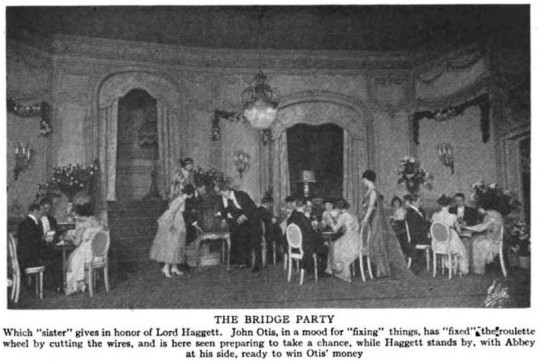
Bridge whist is a card game popular in the early 20th century. It was derived from whist with the additional rules that the players would take turns as dummy and that the trump suit would be deliberately chosen (including the option not to have one) on each deal rather than random.
"Next Thursday night will be ‘police night' at Maxine Elliott's Theater, when the members of the police department gambling squad will attend in a body to see the performance of William Hodge in ‘Fixing Sister,' in order to enjoy the spectacular police raid of a gambling party, which furnishes an exciting climax to the third act.” ~ EVENING STAR

The somewhat odd title was one of a dozen considered by Hodge. It was originally announced as The Social Climbers, but that seemed too similar to Clyde Fitch’s 1901 play The Climbers.
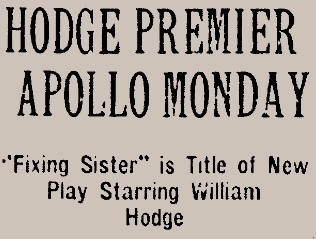
Fixing Sister opened in Atlantic City at Nixon’s Apollo Theatre on January 16, 1916. From there, it traveled to Wilmington DE, Altoona PA, Pittsburgh PA, and Boston MA.
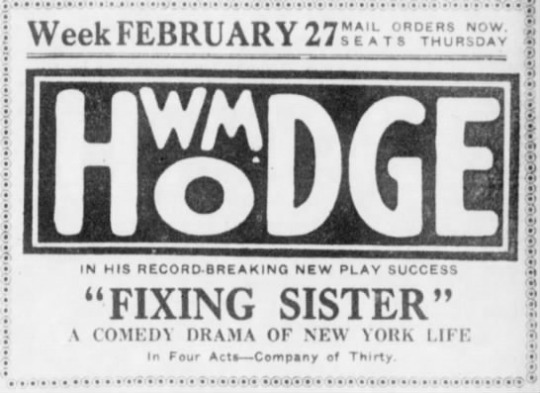
After Beantown (Boston), Hodge and company went to the Motor City (Detroit) before returning to Boston’s Majestic, where business was brisk.
“As an indication of the volume of business being done, it was necessary, on Ash Wednesday, to place the orchestra on the stage and sell seats in the pit usually occupied by the musicians.”
In mid-March 1916, Hodge made a formal announcement confirming the rumors that he was indeed playwright Lawrence Whitman. At the end of March, Hodge took on a second play in his downtime: Hobson’s Choice at the Wilbur. He requested that Mr. Shubert cancel one of his Fixing Sister matinees so that he might perform in Hobson’s, but Shubert declined. Instead, he arranged a special benefit of Hobson’s at an alternate time.

Although the above item appears to be an article, it is actually a paid advertisement! Do not send Miss Maxwell-Conover stray cats!
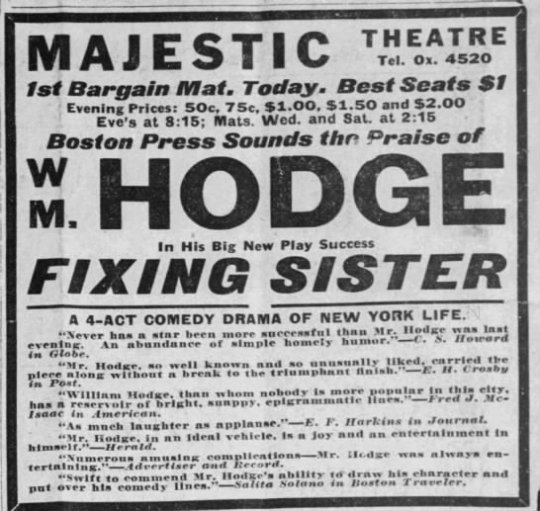
The Boston engagement finally came to an end on April 22, 1916. Although Broadway seemed the next logical step, the play moved to Maine through the end of the month. Hodge then retired to his summer home on Long Island to be with his wife and three small children, looking forward to bringing the play to Broadway in the new season.

Getting the play back on its feet, Hodge chose Pittsburgh, returning to the Alvin, where the play initially enjoyed a brief stay.

Fixing Sister opened on Broadway at Maxine Elliott’s Theatre (109 West 39th Street) on October 4, 1916.
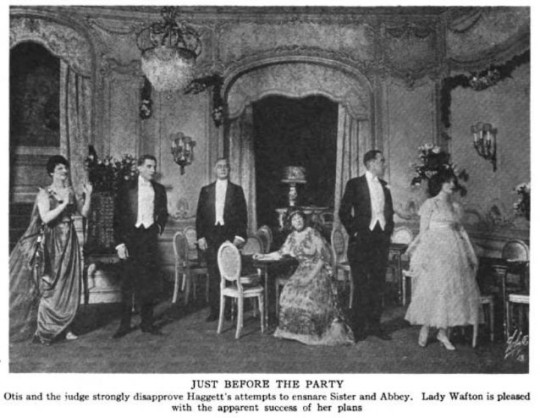
“Early in the play the audience is let into the secret. The onlooker is taken into the confidence of the leading character and the game is won. The audience plays the rest of the piece. The interest and enthusiasm is so alive that it comes in waves to me across the footlights. Such a play is bound to be a delight to both the folk who play it and those who are entertained by it.” ~ WILLIAM HODGE
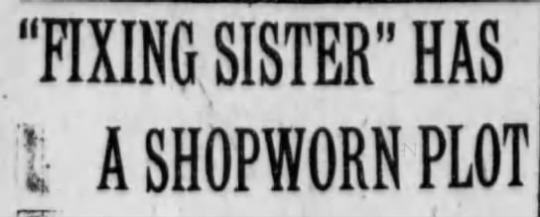
“Mr. Whitman’s play dramatizes the yellow journal idea of society life in Manhattan.” ~ BROOKLYN DAILY EAGLE
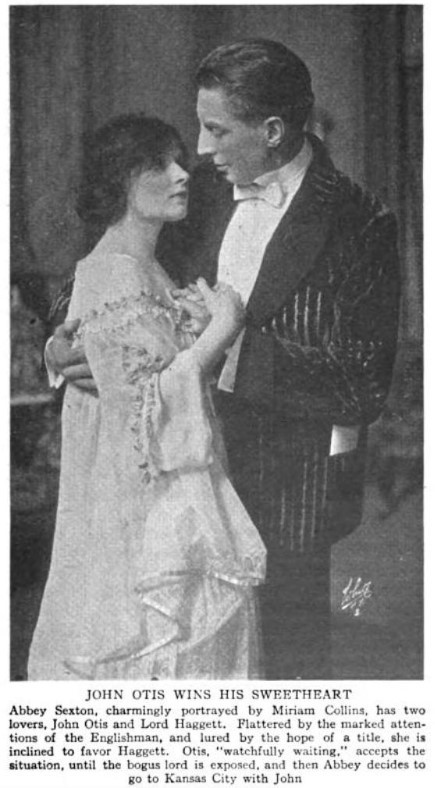
“When will Missouri stop ‘showing’ us New York?” ~ CHARLES DARNTON
Hodge’s character, John Otis, is from Kansas City, Missouri (aka the ‘Show Me’ State)
“Interest is sustained as long as [Hodge] is on the stage, making droll remarks about everything in general in his inimitable manner, but it lags perceptibly when the other characters are depended upon to keep things going.” ~ BROOKLYN LIFE

In early November, the production cleverly addressed rumors that Hodge would close the New York production and tour. A week later, the play was extended, selling advance tickets for as far ahead as New Year’s.
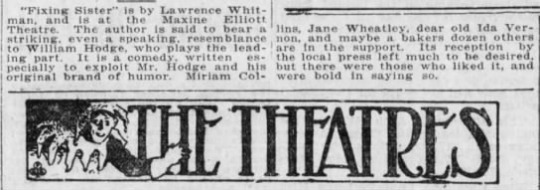
Despite this, Hodge packed his tents and moved the play to Chicago a week before Christmas. It ran on Broadway for 85 performances.
#Fixing Sister#1916#William Hodge#Lee Shubert#Nixon's Apollo Theatre#Atlantic City#Maxine Elliott's Theatre#Broadway#Broadway Play#Broadway Theatre#Lawrence Whitman
24 notes
·
View notes
Text
Maxine Elliott: The Beauty as Builder
Maxine Elliott: The Beauty as Builder
Theatre is ephemeral. We often think of architecture as it’s opposite, the most enduing form of human expression, but here is a reminder that it, too, is temporary at best. I’d long known the name Maxine Elliott only in the context of the Broadway theatre that bore her name. Opening in 1908, Maxine Elliott’s was the site of the American premieres of Synge’s Riders to the Sea and The Playboy of…
View On WordPress
#actress#Broadway#château de L&039;Horizon#Churchill#Maxine Elliott#Maxine Elliott&039;s Theatre#producer#star#theater#theatre
2 notes
·
View notes
Text

Filming has begun on a new production of Alan Bennett’s critically acclaimed and multi-award-winning Talking Heads monologues. Ten of the original pieces – first aired on the BBC in 1988 and 1998 – will be re-made with the addition of two new ones, written by Bennett last year.
Produced by Nicholas Hytner for London Theatre Company (aka The Bridge Theatre) and Kevin Loader, they'll air in the coming months on BBC One.

Jodie Comer in Her Big Chance (1988), directed by Josie Rourke
Monica Dolan in The Shrine (2019), directed by Nicholas Hytner
Martin Freeman in A Chip in the Sugar (1988), directed by Jeremy Herrin
Tamsin Greig in Nights in the Garden of Spain (1998), directed by Marianne Elliott
Sarah Lancashire in An Ordinary Woman (2019), directed by Nicholas Hytner
Lesley Manville in Bed Among the Lentils (1988), directed by Nicholas Hytner
Lucian Msamati in Playing Sandwiches (1998), directed by Jeremy Herrin
Maxine Peake in Miss Fozzard Finds Her Feet (1988), directed by Sarah Frankcom
Rochenda Sandall in The Outside Dog (1998), directed by Nadia Fall
Kristin Scott Thomas in The Hand of God (1998), directed by Jonathan Kent
Imelda Staunton in A Lady of Letters (1988), directed by Jonathan Kent
Harriet Walter in Soldiering On (1988), directed by Marianne Elliott
20 notes
·
View notes
Text
James Reese Europe
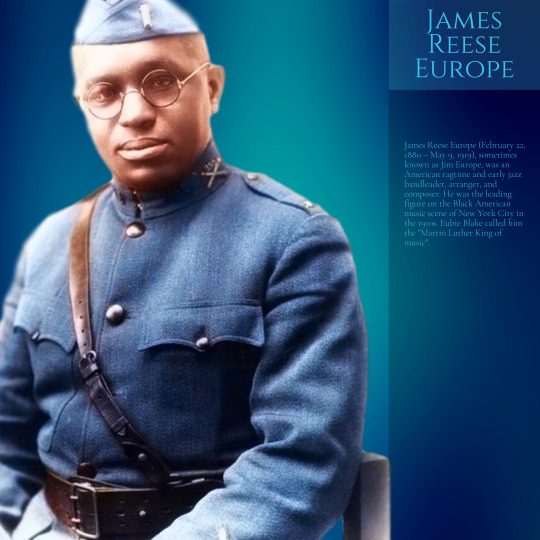
James Reese Europe (February 22, 1880 – May 9, 1919), sometimes known as Jim Europe, was an American ragtime and early jazz bandleader, arranger, and composer. He was the leading figure on the black American music scene of New York City in the 1910s. Eubie Blake called him the "Martin Luther King of music".
Early life
Europe was born in Mobile, Alabama, to Henry Jefferson Europe (1848–1899) and Loraine Saxon (maiden; 1849–1930). His family — which included four siblings, Minnie Europe (Mrs. George Mayfield; 1868–1931), Ida S. Europe (1870–1919), John Newton Europe (1875–1932), and Mary Loraine (1883–1947) — moved to Washington, D.C., when he was 10.
Europe moved to New York in 1904.
Band leader
In 1910, Europe organized the Clef Club, a society for Black Americans in the music industry. In 1912, the club made history when it played a concert at Carnegie Hall for the benefit of the Colored Music Settlement School. The Clef Club Orchestra, while not a jazz band, was the first band to play proto-jazz at Carnegie Hall. It is difficult to overstate the importance of that event in the history of jazz in the United States — it was 12 years before the Paul Whiteman and George Gershwin concert at Aeolian Hall, and 26 years before Benny Goodman's famed concert at Carnegie Hall. The Clef Club's performances played music written solely by Black composers, including Harry T. Burleigh and Samuel Coleridge-Taylor. Europe's orchestra also included Will Marion Cook, who had not been in Carnegie Hall since his own performance as solo violinist in 1896. Cook was the first black composer to launch full musical productions, fully scored with a cast and story every bit as classical as any Victor Herbert operetta. In the words of Gunther Schuller, Europe "... had stormed the bastion of the white establishment and made many members of New York's cultural elite aware of Negro music for the first time". The New York Times remarked, "These composers are beginning to form an art of their own"; yet by their third performance, a review in Musical America said Europe's Clef Club should "give its attention during the coming year to a movement or two of a Haydn Symphony".
Europe was known for his outspoken personality and unwillingness to bend to musical conventions, particularly in his insistence on playing his own style of music. He responded to criticism by saying, "We have developed a kind of symphony music that, no matter what else you think, is different and distinctive, and that lends itself to the playing of the peculiar compositions of our race ... My success had come ... from a realization of the advantages of sticking to the music of my own people." And later, "We colored people have our own music that is part of us. It's the product of our souls; it's been created by the sufferings and miseries of our race."
Some of Europe's best-known compositions include several that were co-composed with Ford Dabney (1893–1958) for the famed dancers Irene and Vernon Castle. The Castles regarded Europe's Society Orchestra among the best they had worked with and hired Europe late in 1913 as their preferred band leader with Dabney as their arranger.
Co-composed with Dabney for the Castles; Joseph W. Stern (1870–1934), publisherComposed soley by Europe for the Castles; G. Ricordi & Co., publisher
Co-composed with Dabney for Kern and Bolton's
Nobody Home
(1915)— Princess Theatre April 20, 2015, through June 1915; Maxine Elliott's Theatre June 7, 1915, through August 7, 1915
Co-composed with Dabney, lyrics by Gene Buck, for Ziegfeld's
Midnight Frolic,
sang by Nora Bayes; Francis, Day & Hunter Ltd., publisher
"Boy of Mine" (©1915)
In 1913 and 1914 he made a series of phonograph records for the Victor Talking Machine Company. These recordings are some of the best examples of the pre-jazz hot ragtime style of the U.S. Northeast of the 1910s. These are some of the most accepted quotes that are in place to protect the idea that the Original Dixieland Jass Band recorded the first jass (spelling later changed) pieces in 1917 for Victor. Unlike Europe's post-War recordings, the Victor recordings were not called nor marketed as "jazz" at the time, and were far from the first recordings of ragtime by Black American musicians.
Neither the Clef Club Orchestra nor the Society Orchestra were small "Dixieland" style bands. They were large symphonic bands to satisfy the tastes of a public that was used to performances by the likes of the John Philip Sousa band and similar organizations very popular at the time. The Clef Orchestra had 125 members and played on various occasions between 1912 and 1915 in Carnegie Hall. It is instructive to read a comment from a music review in the New York Times from March 12, 1914: "... the programme consisted largely of plantation melodies and spirituals [arranged such as to show that] these composers are beginning to develop an art of their own based on their folk material ..."
Military service
During World War I, Europe obtained a commission in the New York Army National Guard, where he fought as a lieutenant with the 369th Infantry Regiment (the "Harlem Hellfighters") when it was assigned to the French Army. He went on to direct the regimental band to great acclaim. In February and March 1918, James Reese Europe and his military band travelled over 2,000 miles in France, performing for British, French and American military audiences as well as French civilians. Europe's "Hellfighters" also made their first recordings in France for the Pathé brothers. The first concert included a French march, and the Stars and Stripes Forever as well as syncopated numbers such as "The Memphis Blues", which, according to a later description of the concert by band member Noble Sissle "... started ragtimitis in France".
Post-war career
After his return home in February 1919 he stated, "I have come from France more firmly convinced than ever that Negros should write Negro music. We have our own racial feeling and if we try to copy whites we will make bad copies ... We won France by playing music which was ours and not a pale imitation of others, and if we are to develop in America we must develop along our own lines." In 1919 Europe made more recordings for Pathé Records. These include both instrumentals and accompaniments with vocalist Noble Sissle who, with Eubie Blake, would later have great success with their 1921 production of Shuffle Along, which gives us the classic song "I'm Just Wild About Harry". Differing in style from Europe's recordings of a few years earlier, they incorporate blues, blue notes, and early jazz influences (including a rather stiff cover record of the Original Dixieland Jass Band's "Clarinet Marmalade").
Death
On the night of May 9, 1919, Europe performed for the last time. He had been feeling ill all day, but wanted to go on with the concert (which was to be the first of three in Boston's Mechanics Hall). During the intermission Europe went to have a talk with two of his drummers, Steve and Herbert Wright. After Europe criticized some of their behavior (walking off stage during others' performances), Herbert Wright became very agitated and threw his drumsticks down in a seemingly unwarranted outburst of anger. He claimed Europe did not treat him well and that he was tired of getting blamed for others' mistakes. He lunged for Europe with a penknife and was able to stab him in the neck. Europe told his band to finish the set and he would see them the next morning. To Europe and his band the wound seemed superficial. As he was carried away, he told them "I'll get along alright." At the hospital, they could not stop the bleeding and he died hours later.
News of Europe's death spread fast. Composer and band leader W. C. Handy wrote: "The man who had just come through the baptism of war's fire and steel without a mark had been stabbed by one of his own musicians ... The sun was in the sky. The new day promised peace. But all the suns had gone down for Jim Europe, and Harlem didn't seem the same." Europe was granted the first ever public funeral for a black American in the city of New York. Tanney Johnson said of his death: "Before Jim Europe came to New York, the colored man knew nothing but Negro dances and porter's work. All that has been changed. Jim Europe was the living open sesame to the colored porters of this city. He took them from their porters' places and raised them to positions of importance as real musicians. I think the suffering public ought to know that in Jim Europe, the race has lost a leader, a benefactor, and a true friend."
At the time of his death, he was the best-known black-American bandleader in the United States. He is buried in Arlington National Cemetery.
4 notes
·
View notes
Note
heard u have children now
Deception is a 1946 movie released by Warner Brothers, and directed by Irving Rapper. The film is based on the play Monsieur Lamberthier by Louis Verneuil. The screenplay was written by John Collier and Joseph Than. It stars Bette Davis, Paul Henreid, and Claude Rains who had also appeared together in the highly successful Now, Voyager (1942).[3] The film was based on a play Monsieur Lamberthier by Louis Verneuil, which was first performed in Paris in 1927. It opened on Broadway as Jealousy on October 22, 1928 at Maxine Elliott's Theatre, as a two-hander (play with only two main characters), with Fay Bainter and John Halliday. It was turned into a film also entitled Jealousy (1929) with Jeanne Eagels and Fredric March and directed by Jean de Limur. The play was presented again on Broadway on October 1, 1946 under the title Obsession at the Plymouth Theatre, with Eugenie Leontovich and Basil Rathbone. Warner Bros. originally purchased the play as a vehicle for Barbara Stanwyck and Paul Henreid. Davis' solo piano playing was performed by Shura Cherkassky. Henreid's cello playing was dubbed by Eleanor Aller. The music for Hollenius' Cello Concerto was by Erich Wolfgang Korngold, who composed the music for this film. Korngold subsequently expanded this material and published it as his own cello concerto.
1 note
·
View note
Photo

Broadway north from 38th St., New York City, showing the Casino and Knickerbocker Theatres, a sign pointing to Maxine Elliott's Theatre, which is out of view on 39th Street, and a sign advertising the Winter Garden Theatre, which is out of view on 50th Street. The Metropolitan Opera House and Times Tower are visible on the left.1920 http://ift.tt/2F5nbW8
0 notes
Photo

Horse Eats Hat - Maxine Elliott's Theatre Metal Photo Print http://ift.tt/2lWphhQ. More items http://bit.ly/2hyOutM
0 notes
Photo

Broadway north from 38th St., New York City, showing the Casino and Knickerbocker Theatres, a sign pointing to Maxine Elliott's Theatre, which is out of view on 39th Street, and a sign advertising the Winter Garden Theatre, which is out of view on 50th Street. The Metropolitan Opera House and Times Tower are visible on the left. Date 1920
0 notes
Text
ALL SOULS’ EVE
1920
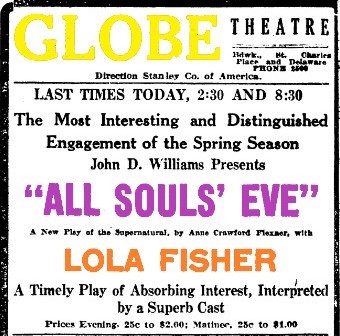
All Souls’ Eve is a play of the supernatural by Anne Crawford Flexner. It was originally produced by John D. Williams, staged by Homer Saint-Gaudens starring Lola Fisher in the dual role of Alison and Norah.
The play is set in Jim Heath's Study, the Nursery, the Lanai of Jim's home on Mt. Tantalus outside Honolulu, on all Soul's Eve
Norah O’Donnell is a young girl living in Ireland. She believes that on All Souls' Eve the spirits of the dead return to visit those whom they loved in life. Norah sails to American to join her mother, but finds that her mother has died. Norah takes up a position as a nursemaid with the Heath family. Jim Heath and his wife Alison have one young son, Peter. Olivia Larkin is in love with Jim, and desperately jealous of Alison. When she finds that she is unable to lure him away from his wife, she convinces a madman that Alison is the one responsible for his misfortunes. The madman murders Alison, and Jim, devastated by his wife's death, neglects his work and his son, turning to drink and Olivia for solace.
On All Souls' Eve, Peter falls seriously ill. Norah tries to rouse Jim, but he is too drunk to respond. She sends for a doctor, but before he can arrive, the soul of Alison appears and, unable to save her son herself, transfers her love for him into Norah, who saves Peter's life. After this, Jim finds that Norah becomes ever more like Alison and shuns Olivia and drink as he comes to realize that he loves Norah. Olivia is pursued to her death by the madman, and Norah becomes Jim's wife and mother to Peter.
About the Title: All Souls' Day, also known as the Day of the Dead, is a day of prayer and remembrance for the faithful departed, which is observed by Roman Catholics and other Christian denominations annually on 2 November.
All Souls’ Eve premiered on April 19, 1920 in Washington DC at the Shubert-Belasco Theatre. It was a benefit for the Women’s Clubs. It then played the Grand in Wilkes-Barre PA and the Lyric in Allentown.

All Souls’ Eve opened in Atlantic City at the Globe Theatre on the Boardwalk on April 29, 1920. From AC the play moved to the Court Square Theatre in Springfield MA.

All Souls’ Eve opened on Broadway at Maxine Elliott’s Theatre (109 West 39th Street) on May 12, 1920.
About the Venue: Lee Shubert sold actress Maxine Elliott the land for this theatre in exchange for fifty-percent interest in it - making Elliott one of the only female managers. It was leased to the Federal Theatre in 1936. In 1941, it became a radio station and, later, a television studio. In 1956, Elliott's heirs sold her share to the Shuberts, who then sold the property. It was demolished in 1960.
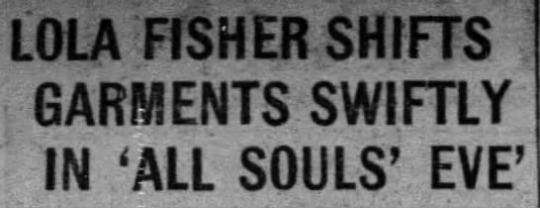
“One moment a vocal wraith, swathed in misty chiffons, Miss Fisher floats about; and having wafted herself gracefully behind the screen which, the audience is told to believe, shields the couch of the sleeping nurse, she delivers Norah’s lines from that vantage point. The scene seemed to me to be handled with excessive clumsiness, although I scarcely see how it could have been done otherwise.” ~ McELLIOTT, NY DAILY NEWS

“Its defects are verbosity and Mrs. Flexner's inability to maneuver her plot with anything approaching dexterity. Most of the dialogue is flat, devious and uninteresting. It tells the story at a snail's pace, with many delays and considerable stuttering.” ~ BROOKLYN DAILY EAGLE
The play closed at Maxine Elliott’s on June 12th after 21 performances.

In 1921, the play was filmed starring Mary Miles Minter. Much was made of the film's use of double, triple and quadruple exposures to enable Minter to play two parts within the same scenes. It is now thought to be a lost film.
In reviewing the play, Heywood Braun said:
“The Flexner play was financed by some of that awful ‘movie money' we have heard so much of lately and is unquestionably designed for screen use later - Furthermore, It will make a better picture than It does a play.”
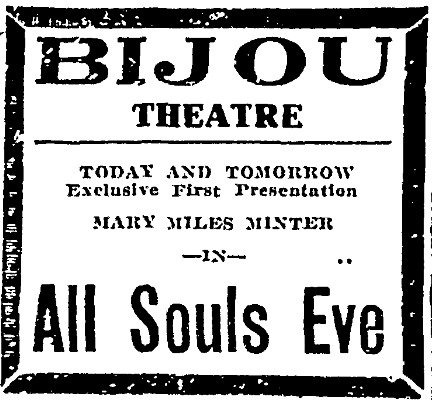
The film opened in Atlantic City at the Bijou Theatre on the Boardwalk on March 14, 1921.
#All Souls' Eve#Mary Miles Minter#Lola Fisher#Broadway#Broadway Play#Globe Theatre#Bijou Theatre#Maxine Elliott's Theatre#Atlantic City#Boardwalk#1920
3 notes
·
View notes
Photo

6 notes
·
View notes
Text
LOVE O’ MIKE
1916 - 1918

Love O’ Mike is a musical comedy in two acts and a prologue by Jerome Kern (music), Harry Smith (lyrics), and a book credited to Thomas Sydney (a pseudonym for Augustus Thomas and Smith’s son Sydney) with additional lyrics by Herbert Reynolds. It was originally produced by Elizabeth Marbury and Lee Shubert, staged by J.H. Benrimo. The cast featured Lawrence Grossmith (Lord Michael Kildare), Allison Bain (Mrs. Marvin), George Hassell (Bif Jackson), Clifton Webb (Alonzo Bird), Vivian Wessell (Vivian), Luella Gear (Luella) and Peggy Wood (Peggy), among others.
The musical was formerly titled Girls Will Be Girls. It was changed to avoid confusion with another musical of the same title. Love O’ Mike was one of the script’s original titles along with Strike the Lyre.
The musical takes place at Mrs. Marvin’s home in Bronxville, New York.
All the girls at Mrs. Marvin’s house party fall in love with Lord Michael Kildare (the Mike of the title), but he only has eyes for Vivian. The party is marred when the butler, a sometimes second-story man, steals one young lady’s money. Then Mike takes credit for rescuing people from a local tenement fire. His bravery further mars the fun of the male members of the party, who must endure watching their girls’ adulation of Mike run out of control. With the butler, the men plot a phony rescue to counter Mike’s claims of heroics. But the two-faced butler tells Mike and the girls of the plan.
Under the title Girls Will Be Girls, the show premiered at Philadelphia’s Lyric Theatre on November 20, 1916. In January 1917 it played the Garrick in Detroit and the Alvin in Pittsburgh.
“All the familiar conventions associated with musical plays have been swept aside in the production of ‘Love O' Mike.’ There is no chorus, but there is a cast of sixteen principals; the music helps to develop the story and there is a freshness and spontaneity about the individual performances that aid in the appeal of the entertainment.” ~ COURIER-NEWS

Love O’ Mike opened on Broadway at the Shubert Theatre (255 West 44th Street) on January 15, 1917.
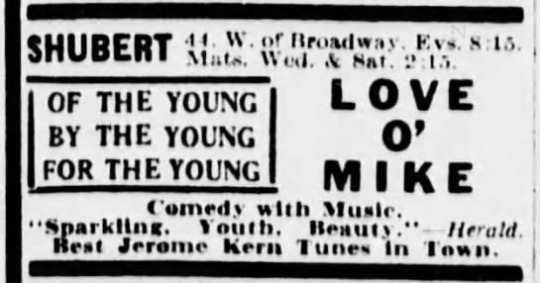
About the Venue: The Shubert Theatre was built by Lee and J.J. Shubert as tribute to their brother Sam, who died in a train crash in 1905. It has rarely been dark since opening in 1913. It is the flagship theatre of the Shubert Organization.
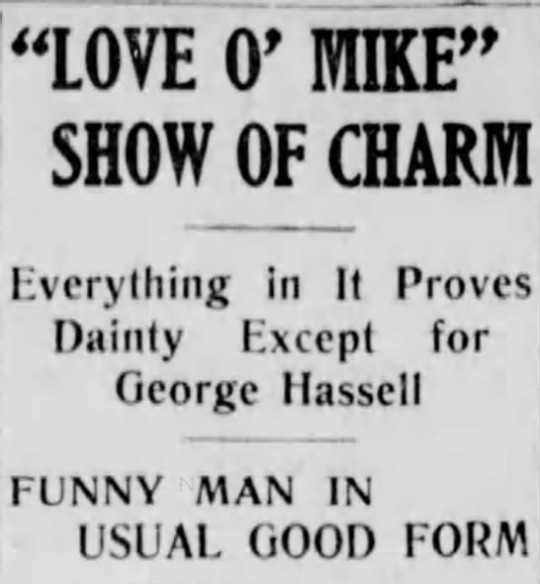
"’Love O’ Mike' is an excellent musical comedy for a pair of beginners, but when that has been said there remains little else that may be stated its favor. With due consideration for their youth and Inexperience, the piece is still disappointing because they had such excellent advisers.” ~ NEW YORK HERALD

The musical transferred to Maxine Elliott’s Theatre (109 West 39th Street) on March 19, 1917 and played there until June 30, 1917.

About the Venue: Lee Shubert sold actress Maxine Elliott the land for this theatre in exchange for fifty-percent interest in it - making Elliott one of the only female managers. It was leased to the Federal Theatre in 1936. In 1941, it became a radio station and, later, a television studio. In 1956, Elliott's heirs sold her share to the Shuberts, who then sold the property. It was demolished in 1960.

After taking the summer months off, the musical re-opened on August 27, 1917 at the Casino Theatre (1404 Broadway at 39th Street). Laurence Grossmith was replaced by Max Leeds, but much of the original cast remained. This relaunch would technically be kicking off a new theatre season. It played there until September 29, 1917.

About the Venue: Built for light musicals and operetta, the Casino showed mostly "polite vaudeville" starting in 1892. In 1903 the Shuberts acquired the lease. A 1905 a fire necessitated much reconstruction. In February of 1930, the theatre was demolished to make room for the expanding garment district.
The total run over all three theatres was 233 performances. After Broadway, the play decamped to Newark before moving to Buffalo and Boston.
The play toured extensively and eventually made its way to Atlantic City.

Love O’ Mike opened in Atlantic City on May 20, 1918 at B.F. Keith’s Garden Pier Theatre. The tour finally wrapped up in June 1918, 19 months after its first performance in Philadelphia.
#Love O' Mike#Jerome Kern#Shubert#Garden pier Theatre#Atlantic City#Peggy Wood#Laurence Grosssmith#George Hassell#Clifton Webb#Musical#Broadway Musical#Musical Comedy#Girls Will Be Girls#Shubert Theatre#Casino Theatre#Maxine Elliott's Theatre
4 notes
·
View notes
Text
EXPERIENCE
1914 / 1915
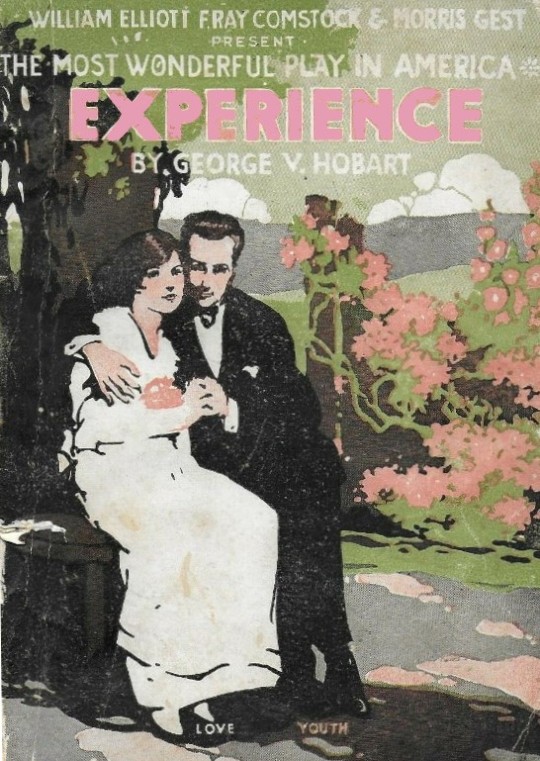
Experience is a three-act play modern morality play by George V. Hobart featuring incidental music by Max Bendix and cabaret music by Silvio Hein. It was originally produced by William Elliott, and staged by J.C. Huffman and Mr. Hobart.
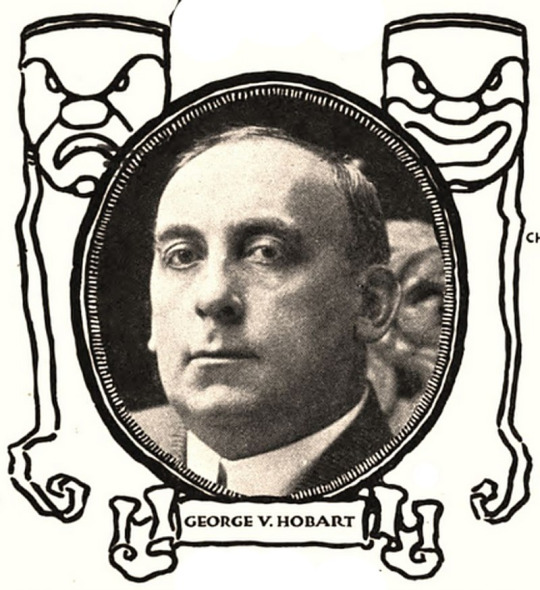
George Vere Hobart (1867-1926) was a Canadian-American humorist who authored more than 50 musical comedy librettos and plays as well as novels and songs. His better-known stage plays include Our Mrs. McChesney cowritten with Edna Ferber, Miss Prinnt, Sonny; Hitchy-Koo of 1919, Buddies, and Sweet Sixteen. At the time of his death, Hobart was considered "one of America's most popular humorists and playwrights".
The play was developed from a one-act performed by the Lamb’s Club at the Metropolitan Opera House. It was fleshed out into three acts and ten scenes.
The play is an allegory in the style of “Everyman”. Characters have representative names like Experience, Love, Youth, Pleasure, Despair, Passion, etc.
In ten unusual and spectacular episodes, "Experience" tell the love story of Youth, the average young man of today, and the adventures he meets when he leaves his home in the country and goes to the big city to make a name for himself. The temptations that he meets are represented by beautiful young girls, who are called by the names of the various vices and virtues they portray in the play. Among the scenes is the Primrose Path of Pleasure in which the gay night life of a great city is shown at its best or possibly worst. In the Corridors of Chance scene a modern gambling house is shown in full operation with every known gaming device actually being played before the audience. In the House of Lost Souls scene the terrible effects of drugs on human beings are shown.
Rehearsals began in early September at the Lyric Theatre NYC.

Experience opened at Nixon’s Apollo Theatre in Atlantic City on September 28, 1914. The play was first announced to premiere in Syracuse NY.

Experience opened on Broadway at the Booth Theatre on October 27, 1914.
About the Venue: Built in 1911 by Winthrop Ames and Lee Shubert, it was named after another Booth Theatre in which Ames' father invested. After Ames' retirement in 1932, the Shuberts leased it for fifteen years, then purchased it in 1948. It is still in operation today.
“Here is a wholesome play that isn't namby-pamby; A clean play with a terrific punch; A play that calls a spade a spade without a trait of salaciousness; A play whose lights are as lurid in the depths as they are glowing on the heights yet which, withal, is a play for every season of life; a retrospect for age, a fact for maturity, a promise for youth. Preachers seldom make good dramatists. He who would inculcate a moral usually inculcates his audience out of the theatre. Yet here is a man who preaches, and teaches, and counsels, yet thrillingly entertains.” ~ CLINTON T. BRAINARD

The play moved to the Casino Theatre (1404 Broadway at 39th Street) on January 11, 1915.
About the Venue: Built for light musicals and operetta, the Casino showed mostly "polite vaudeville" starting in 1892. In 1903 the Shuberts acquired the lease. A 1905 a fire necessitated much reconstruction. In February of 1930, the theatre was demolished to make room for the expanding garment district.
“There were grave doubts, on the part of old-timers who in more than a quarter-century had seen nothing but melodic pieces on the Casino stage, that a spoken drama would succeed. These doubters should have been in the vicinity of the Casino at 8 o’clock on the evening of the play’s opening there. Perhaps some of them were, and if they were, their dubiousness must have been blown to atoms. A line of more than 200 persons faced the box office, and once the show was on the actors confronted the great spaces of the Casino on all three levels packed to capacity with eager and enthusiastic humanity.” ~ PASSAIC DAILY NEWS
In March 1915, the play was issued in book form by the H.K. Fly Publishing Company, complete with 15 engravings of scenes from the play.

Experience moved a third time to Maxine Elliott’s Theatre (109 West 39th Street) on May 3, 1915.
About the Venue: Lee Shubert sold actress Maxine Elliott the land for this theatre in exchange for fifty-percent interest in it - making Elliott one of the only female managers. It was leased to the Federal Theatre in 1936. In 1941, it became a radio station and, later, a television studio. In 1956, Elliott's heirs sold her share to the Shuberts, who then sold the property. It was demolished in 1960.
Experience closed there on June 5, 1915 with a total of 255 performances. Based on its success, Hobart wrote another allegorical play titled Why?, which was also premiered by the Lamb’s. Unfortunately, it never got any further.

On January 22, 1918, the play was revived at the Manhattan Opera House. The creative team was the same as the 1914 production. It ran 23 performances. It was the culmination of a national tour.
#George V. Hobart#Experience#Broadway#Broadway Play#Morality Play#Atlantic City#1914#1915#Nixon's Apollo Theatre#Booth Theatre#Casino Theatre#Maxine Elliott's Theatre#Shubert
1 note
·
View note
Text
READY TO OCCUPY / NO MORE BLONDES
1919

Ready to Occupy (later No More Blondes), is a three act farce by Otto Harbach, based on a story by Edgar Franklin. It was originally produced by A.H. Wood, staged by Bertram Harrison, starring Ernest Truex.
Among other pre-production titles was Oh George, Forgive Me! In June 1919, screen star Doris Kenyon was attached to the project. Rehearsals began in early December without Kenyon.
The play takes place at Harper's Real Estate office, and James Powell's home in New York City.
The plot revolves about the adventures of a newly married couple from Cohoes NY who have come to the big town and are estranged. The bride is bundled off to the Martha Washington Hotel and a real estate friend of the husband's puts him In a house owned by another newly married couple that is supposedly vacant. The Cohoes man is told to be rough to the servants, and he is. He tells the butler he is ‘cheap’ but through the rest of the play the butler proves most expensive. The husband goes to bed and white he sleeps the wife of the owner returns unexpectedly. Later her giant brother comes in, the owner of the house arrives, also the little wife from Cohoes. And each fresh arrival presents a new set of complications.

The play premiered at Parsons’ Theatre in Hartford CT on December 22, 1919.
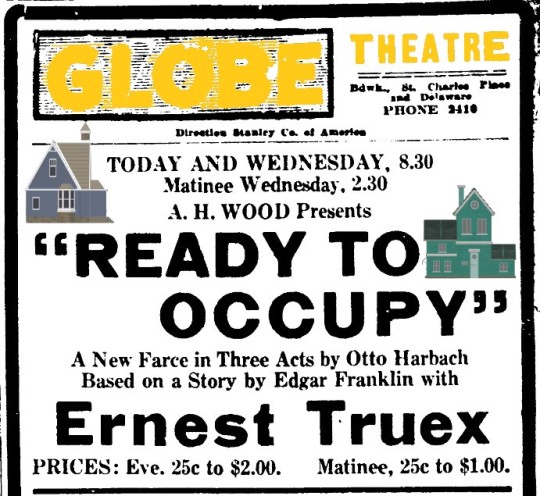
Ready to Occupy opened at Atlantic City’s Globe Theatre on December 23, 1919. After AC NJ, the show moved to the Grand Theatre in Trenton, the state capitol.
On December 30th it was announced that the play would occupy Broadway’s Maxine Elliott’s Theatre starting on January 7, 1920, which is what came to pass...

...except under a new title: No More Blondes. Coincidentally, on the day that the play premiered on Broadway, the Emir of Afghanistan issued a similar edict, banning blondes in his kingdom!

“There is at least a suggestion of the influence of Detroit in the manner in which the farce is assembled. All the parts are standardized. It is built of time-tested and well weathered material, but if an axle or a crankshaft should break suddenly, there ought not to be the slightest difficulty in sending around the corner or up the street to some other farce where the missing part could be duplicated perfectly. Like most of the sound and stable farces of its school, it is not quite able to complete the journey on one winding. It gets under way quickly and works up to a good speed, but then begins to weaken and is coughing a little at the end of the journey.” ~ HEYWOOD BRAUN
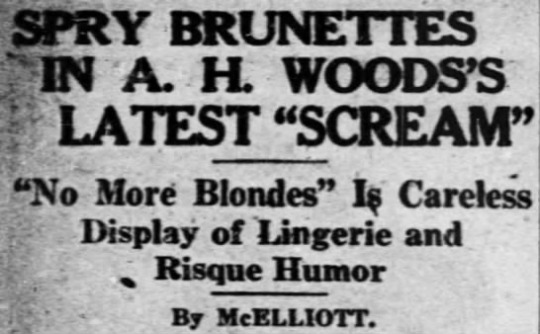
“There is amusement for those who do not bother to discriminate.” ~ NY DAILY HERALD
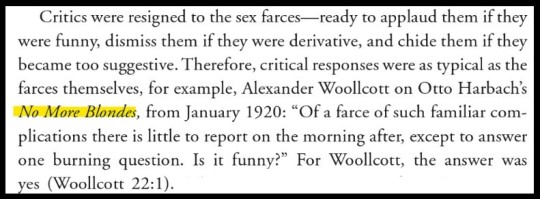
"'No More Blondes' is a second-rate farce comedy. Now this is not nearly so bad a criticism as at first it seems to be. When you realize that almost every play of this kind in New York is tenth-rate, this particular play-goes up in the scale.” ~ ARNOLD W. ROSENTHAL
“An awful blow to the peroxide market.” ~ HOUSTON POST

As a publicity stunt, Woods presented a free performance for natural blondes!
The play closed on Broadway on January 31st after just 29 performances. Truex and company immediately traveled to Washington DC to continue performances. From there it bounced back to Teller’s Shubert in Brooklyn.
#No More Blondes#Ernest Truex#Ready To Occupy#A.H. Woods#Maxine Elliott's Theatre#Globe Theatre#Atlantic City#Broadway#broadway play#theatre#farce#1919#1920#Otto Harbach
0 notes
Text
HE AND SHE / THE HERFORDS
1911-12 / 1917 / 1919-1920

He and She is a play in three acts by Rachel Crothers. Written in 1909, it was first produced in 1911, then again in 1912 under the title The Herfords, but did not appear on Broadway until late 1919 reverting to the title He and She.
‘He and She’ is about a husband and wife who are both trying to have careers as sculptors. They both submit work to a competition, and the wife wins over the the husband, which he does not take well. The wife ultimately decides to leave her work in order to take care of her teenage daughter who is having issues.
The play was given a reading in Carruthers hometown of Bloomington IL in the summer of 1911.
The first staging of the play premiered in Albany New York in mid-November 1911. From there, it moved to Poli’s Theatre in Meriden CT.
The play was scheduled to tour, with no Broadway aspirations, but by the end of the year, star Viola Allen was cast to take the role (She) originated by Emma Dunn. With Allen, the play now had the requisite prestige and an opening at Broadway’s Maxine Elliott’s Theatre was rumored imminent.
Just after the first of the year, the play was reported to be back in rehearsal at Daly’s Theatre in NYC produced by Liebler & Co.
By January 9th the play was headed to the Plymouth, not Maxine Elliott’s. This is when the title was changed to The Herfords, after the surnames of the he and she of the previous title.
By January 22nd, The Herfords had been diverted to Boston, opening on March 1, 1912. It then moved on to tour in other cities, as far afield as Oregon.
By the end of 1912, Crothers had moved onto to new plays: Young Wisdom, and Ourselves, both of which reached Broadway, placing He and She / The Herefords in cold storage. Broadway saw three more Crothers plays before He and She resurfaced in mid 1917.

On June 25, 1917, the "new” production premiered in Atlantic City at Nixon’s Apollo Theatre on the Boardwalk. It was produced by Harris and Cohen and starred Effie Shannon and Maclyn Arbuckle in the title roles. Several New York managers pronounced it “a fine success.” Cohan and Harris placed the play back in rehearsals with thoughts of an October Broadway opening. In early August Maclyn Arbuckle suddenly withdrew from the cast, taking an opportunity to perform with William Faversham in Shaw’s Misalliance.
Maclyn made a shrewd move because the Crothers play on Broadway in October was titled Mother Carey’s Chickens, not He and She. In November 1917 a new Crothers play premiered in Atlantic City titled Once Upon a Time. It, too, moved to Broadway and once again, He and She fell by the wayside.
In June 1919, the play resurfaced again - Crothers’ resume considerably bolstered. She now wished to act as well as write. Interestingly, the play had already been released for stock and amateur performances some time earlier.

At the start of the 1919-20 season the Shuberts announced their intention to produce He and She for Broadway, calling it a “new play.” In this production, Crothers herself took the role of Mrs. Herford (aka She), and Cyril Keightley played Mr. Herford (He), with film star Faire Binney in the mix. The role of Mrs. Herford was supposedly based on Carruthers’ mother. The play launched a pre-Broadway tryout tour in Baltimore in June 1919.
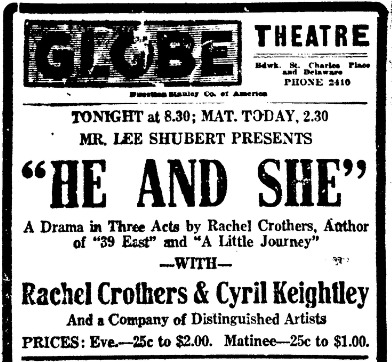
On its way to Broadway, the play stopped (again) in Atlantic City at the Globe Theatre on the Boardwalk on February 9, 1920. It moved immediately (24 hours later), to Broadway.

He and She (finally) opened on Broadway on February 12, 1920 at the Little Theatre (now the Hayes) 240 West 44th Street, Broadway’s smallest and most intimate venue
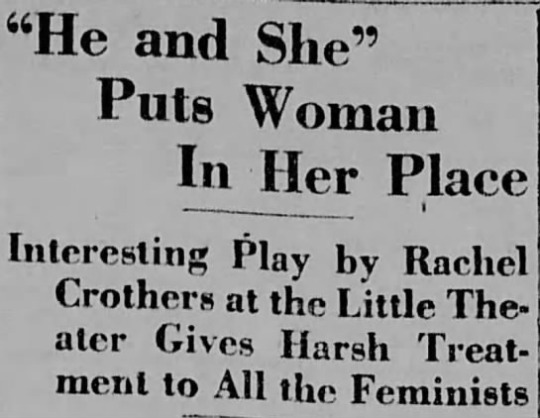
“Miss Crothers herself played pert of the artist's wife. Under strain of being author and leading lady too she was visibly nervous. In her quieter scenes she was excellent but when was called upon to played the tenser moments she played hard and hammered her lines with rather disturbing vehemence. Cyril Keightley gave an excellent performance, but the rest of the cast was not very good.” ~ HEYWOOD BRAUN
“The authoress acts well, although in the more exciting moments she is crude and overplays." ~ BROOKLYN TIMES UNION
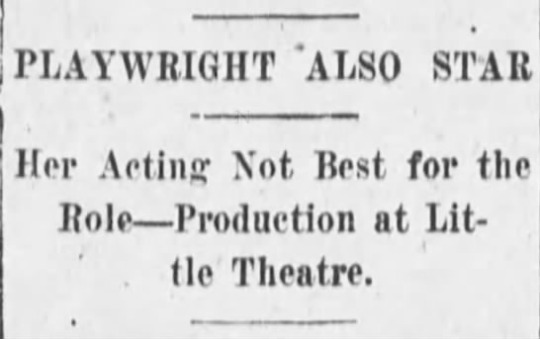
” The staleness of some of the sentiments might justify the rumor of the play's age, but It would not have been enlivening at any period.” ~ THE SUN & NEW YORK HERALD
“’He and She' seems peopled less with folks than with embodied points of view, and the play seems less a dramatic story than a symposium." ~ ALEXANDER WOOLCOT

On March 21, 1920, Crothers wrote a letter to the editor of The Tribune to take issue with the manipulation of an interview she gave with the newspaper. She claimed the author characterized her unfairly and manipulated her words about the New York critics.
He and She closed on Broadway after just 28 performances. Crothers continued to write and direct on Broadway until 1943, scoring more than a dozen more new plays but she never acted on Broadway again.
#He and She#Rachel Crothers#The Herfords#Broadway#Broadway Play#Atlantic City#Feminism#Stage#Globe Theatre#Nixon's Apollo Theatre#Little Theatre
2 notes
·
View notes
Text
WHEN HELL FROZE
1930

When Hell Froze is a play by William Daniel Steele and Norma Mitchell, based on a Harper Prize-winning short story by Mr. Steele. The original production was produced by Kenneth McGowan and Joseph Verner Reed, staged by John D. Williams, and designed by Mr. Steele. It starred Helen MacKellar.
It was billed as a ‘new comedy about obstinate people’ and tells the story of a farm wife that is branded as a harlot by the narrow-minded farm folk of the town.
In July 1929, the playwrights were interviewed by Jessie Henderson of the Standard-Examiner and discussed When Heaven Froze.

If it proves successful Mr. Steele says he's a good mind to write another called "When Heaven Boiled"!
"But you couldn't laugh" Miss Mitchell admonished. "It's a serious play It's theme is very American"
Murders? Bootleg? Guns? Politics?
"None of those.” Mr. Steele assured us, which is a news item In itself.
"Just life. Life on a farm.”
Does virtue triumph?
"Oh no!" the co-authors said as one man in a shocked voice.
It sounded like a good play so we asked Mr. Steele's opinion of the American drama in general.
"If my play succeeds" he an answered "I can safely say that drama in America Is on a high and substantial plane. If it does not, I despair of the American theatre."
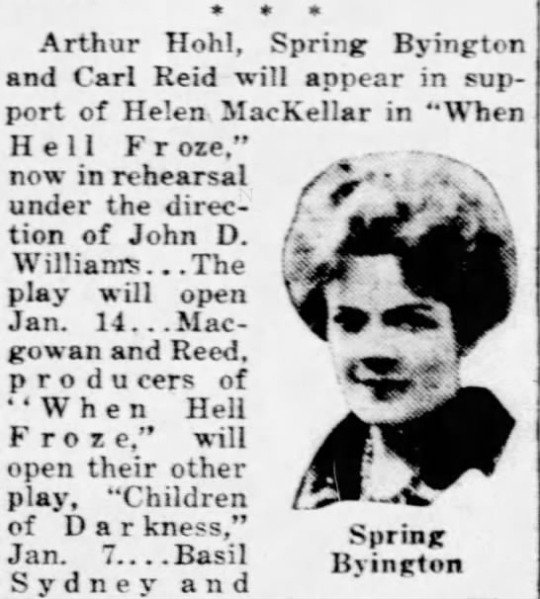
In mid-December, the casting of Arthur Hohl, Carl Reid, and Spring Byington was announced. Byington’s career later included a seven-year run on radio and television as the star of “December Bride”. In 1938, she received an Oscar nomination for her role in You Can't Take It with You.
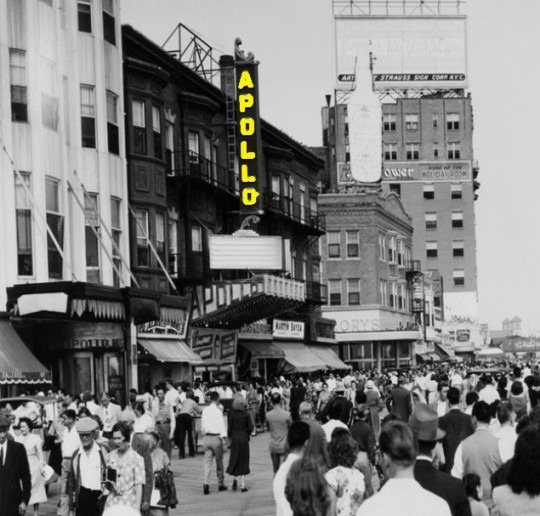
The world premiere took place at Nixon’s Apollo Theatre on the Boardwalk in Atlantic City on January 6, 1930. Next stop Maxine Elliott’s Theatre on Broadway!
The Atlantic City Press called it a “Slow Moving Play”:
“Miss MacKellar always finds a friendly audience in Atlantic City. This part keeps her washing dishes and peeling potatoes so much that it is not until the end of the second act that she gest much opportunity to display her talents. After that she isn’t seen until the end of the play.” ~ J.J. FARRELL, ATLANTIC CITY PRESS
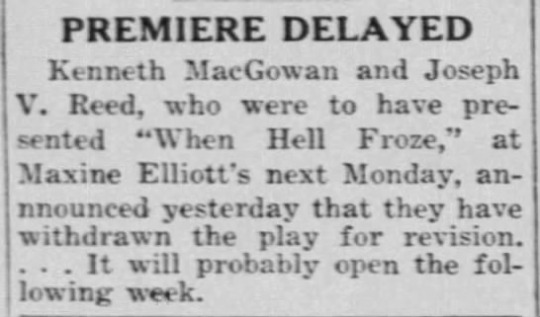
A day after the AC engagement ended, newspapers announced a delay.

By March, the production was said to be postponed “until next season.” MacKellar would be replaced by Jane Cowl, who would play it in rep with Twelfth Night, directed now by Frederick Stanhope, set for October 14 at Maxine Elliott’s.
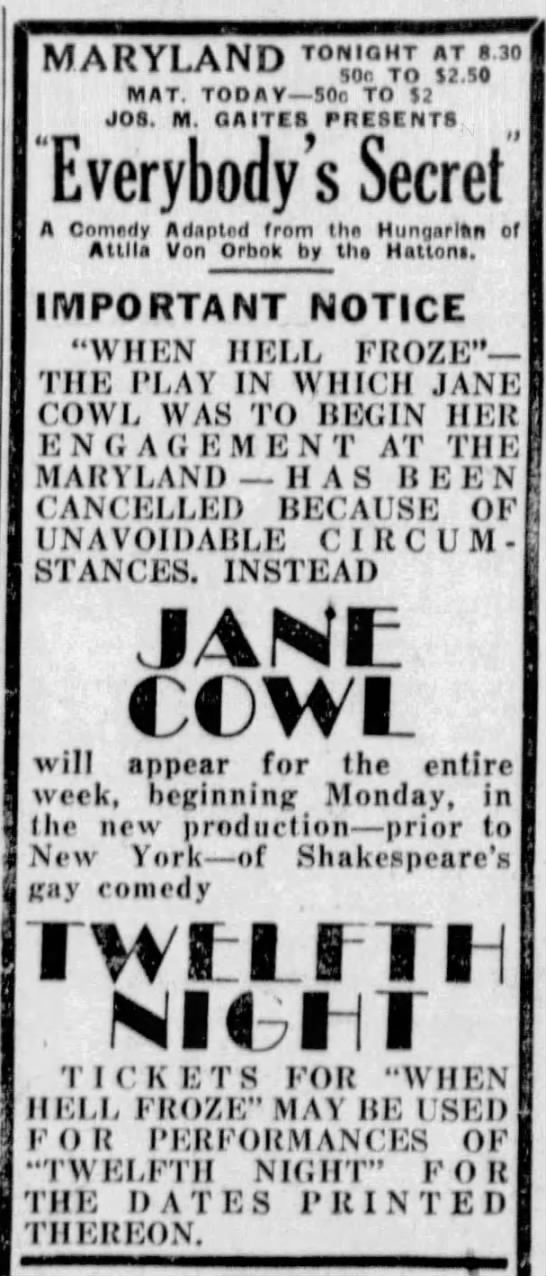
But when after advertising the rep, When Hell Froze was again cancelled, this time citing “unforeseen circumstance”. The out-of-town tryout in Baltimore would only present Twelfth Night.
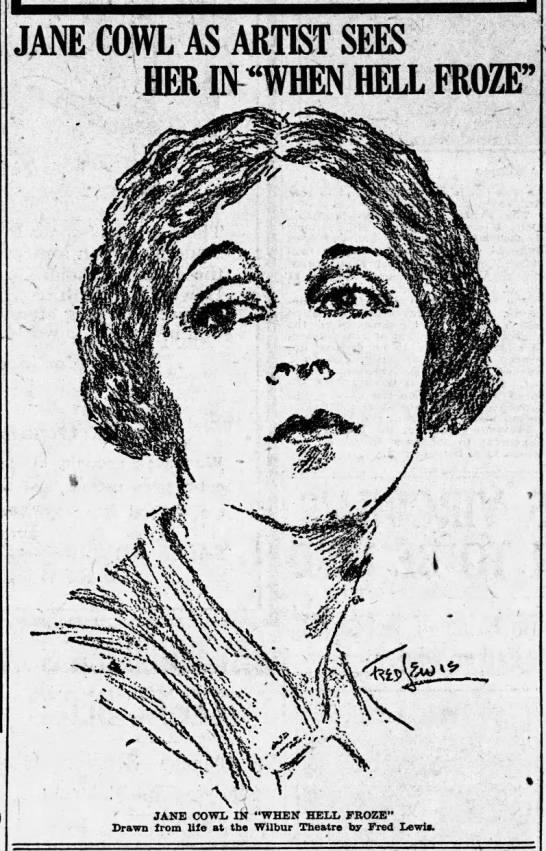
Cowl traveled to Boston where critics savaged Hell, and it was swiftly withdrawn. Plans for their next stop (Broadway) had her eventually replacing Hell with another 20th century play to rep with Twelfth Night, but that, too, never happened. Instead, Cowl opened the Shakespeare play by itself on Broadway at Maxine Elliott’s on October 15, 1930. It played 65 performances.
Even if When Hell Froze never made it to Broadway, it still had an impact.
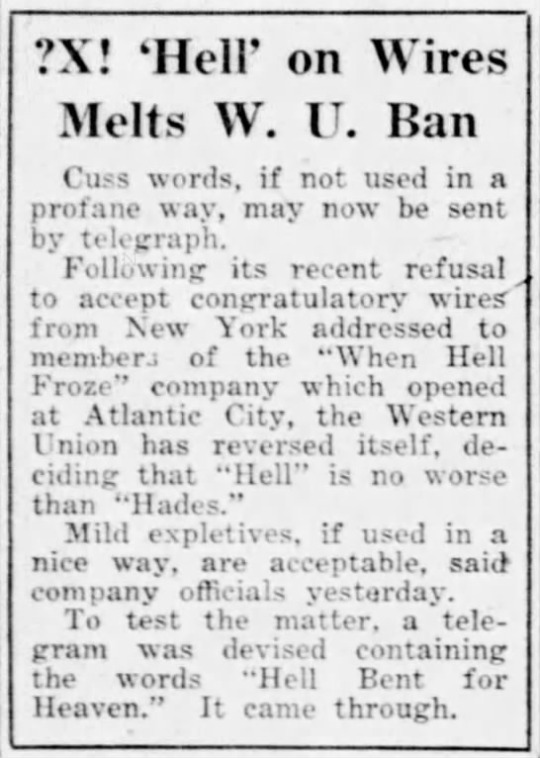
After the play’s first performance, a congratulatory telegram would help change Western Union policy about foul language. Oh, Hell!
#Jane Cowl#When Hell Froze#Atlantic City#Maxine Elliott's Theatre#Nixon's Apollo Theatre#Spring Byington#Helen MacKellar#William Daniel Steele#Norma Mitchell
3 notes
·
View notes
Text
HELLO LOLA
1925

Hello Lola is a three act musical by William B. Kernell (music) and Dorothy Donnelly (book and lyrics), based on the novel Seventeen by Booth Tarkington and the 1918 stage adaptation Seventeen by Hugh Stanislaus Stange and Stannard Mears.
The musical takes place at the Baxter and Parcher homes in Indianapolis in 1900.In the story, Willie Baxter becomes infatuated with a Lola, a shallow, baby-talking minx visiting for the summer. The local girls see through her. When her visit is over, Willie is devastated, but his handyman Genesis convinces him that life goes on.

The original production was produced by Lee and J.J. Shubert. It opened on Broadway at the Eltinge 42nd Street Theatre on January 12, 1926. On February 8th it moved to Maxine Elliott’s Theatre on 39th Street. The musical closed on February 20, 1926 after just 47 performances.
To say that Lola’s road to Broadway was a bumpy ride would be an understatement. Even once at its destination, the musical didn’t settle down.

The first performance was held at the Broad Street Theatre in Newark, New Jersey, on November 16, 1925. It stayed there for a week before moving south to Nixon’s Apollo Theatre in Atlantic City. It made one more stop in Washington DC before the Shuberts decided that the show would take a break for the holidays.

Although initial out-of-town notices were kind, problems were apparent from the beginning. Although Lawrence Marston was credited as director on the road, his name was curiously absent once the show arrived in New York. Even the Shuberts left their name off the title page, a stunning ‘no confidence’ vote by Lola’s godfathers. This was painfully apparent by their choice of venue. A Shubert musical was unlikely to be plugged into the more intimate Eltinge. They quickly were shuffled off to 39th Street’s to die. With its out-of-the-way location and low patron cap, the Maxine Elliott was Lola’s hospice.

The title role was initially played by Madeline Fairbanks, but she was fired on the road and replaced with Edythe Baker (above). Baker’s specialty was playing the piano, so the the score integrated a piano solo for her. This required the production to justify why there’s a piano on the lawn!
“She can play the piano, but she can’t play Lola.” ~ BURNS MANTLE
The New York critics were not kind to Baker (one calling her “a total loss”) and she left the show a few days in. She was replaced by her understudy, who was playing May Parcher. When Baker went, so did her grass-side piano solos.

Baker wasn’t the only one maligned by the punters. Marjorie White, who played Willie’s sweet younger sister Jane, was called ““a miniature Texas Guinan” and compared to Sophie Tucker. The best the crix could say about her was that she was “vociferous”.
The New York Times called the casting “a weirdly assembled collection of principals”. The score, while not offensive, was not memorable. Except for “My Baby-Talk Lady” which was sung no less than four times in the evening. That’s one more time than standard advertising messages.

The other complaint was that the teenagers of the story (remembering the title of the source material) were mostly played by adults. White Way wags dubbed the show Booth Tarkington’s “Thirty-Seven”. The press urged Tarkington’s friends to keep him away. [Note: The above blind item about a raid by the Gerry Society (aka New York Society for the Prevention of Cruelty to Children founded by Elbridge T. Gerry), may have been facetiously apocryphal.]
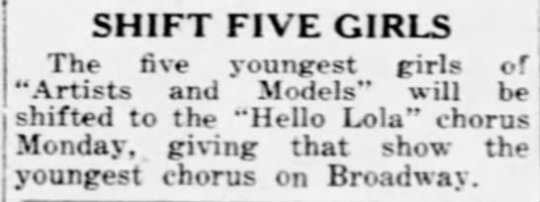
Apocryphal or not, at the beginning of February the production reacted by doing a chorus swap.
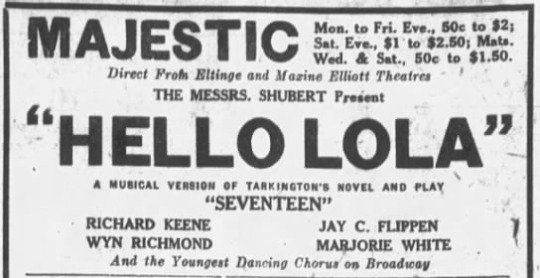
After saying goodbye Broadway, Hello Lola said hello Brooklyn, decompressing at the Majestic, but not venturing any further.

Possibly the only cast member to be the right age was seventeen year-old Margaret Brooke Sullavan, who made her Broadway debut as Miss Boke. To get her “big break” she lied about her age, telling producers she was a few years older than she actually was. During her career, she preferred stage to screen, but in 1939 she was nominated for an Oscar for Three Comrades. Her husbands included Henry Fonda, William Wyler, and Leland Hayward.
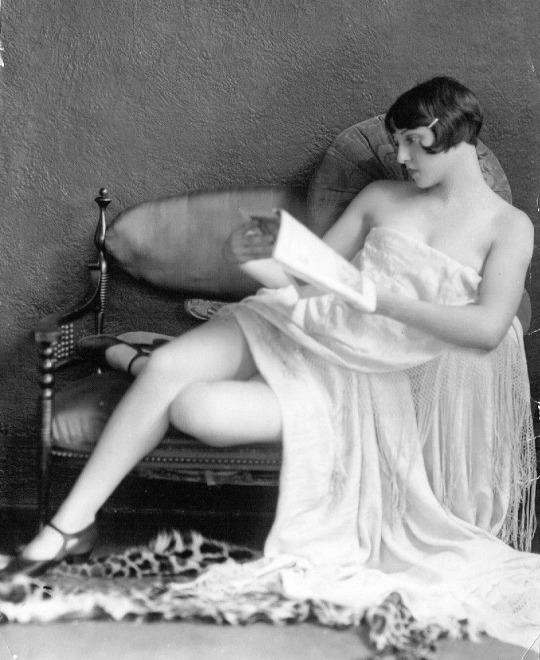
Ensemble member Sylvia Carol was depicted in several provocative photos subtitled “Relaxing on the set of ‘Hello Lola’”.

In an attempt to right the sinking SS Lola, two popular songs were interpolated into the score: “Has Anybody Seen My Gal?” and “That Certain Party,” both sung by Jay C. Flippen as Genesis, the Baxter’s caretaker. In 1925, this was a ‘burnt cork part’ (aka blackface). Flippen had been discovered by famed African-American comedian Bert Williams, and also served as his replacement in a previous show. Flippen went on to a prolific career in films and television.

Despite the failure of Hello Lola, the source material still had life in it. In 1940 there was a feature film starring Jackie Cooper and Betty Field.

In 1951, the Shuberts tried again with a new musical version of Seventeen starring Kenneth Nelson and Ann Crowley. It was adapted by Sally Benson (Junior Miss) with music by Walter Kent and lyrics by Kim Gannon. It bested its predecessor’s run by 135 performances.
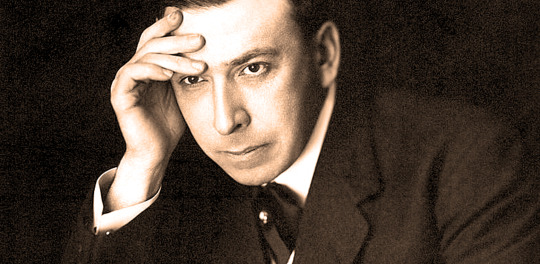
Booth Tarkington died in 1946, so he was spared a second failed musical of Seventeen, which was also (as of this writing) the last Broadway credit with his name attached. His greatest success on stage was 1918′s Clarence, which ran 300 performances and started in Atlantic City! But that’s another blog.
#Hello Lola#Seventeen#Booth Tarkington#Shuberts#1926#Atlantic City#Musical#Broadway#Eltinge Theatre#Maxine Elliott's Theatre#Margaret Sullavan#Sylvia Carol#Marjorie White#Edythe Baker
1 note
·
View note